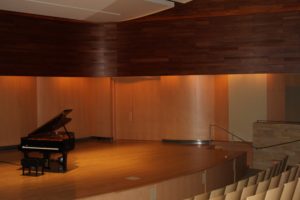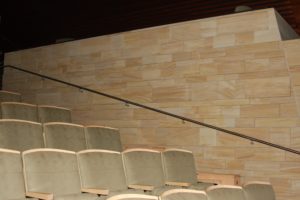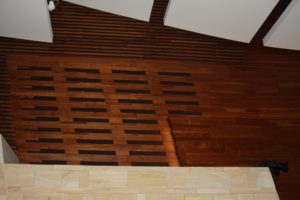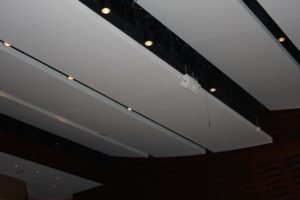MIM – Scottsdale, Arizona USA
The MIM is located in Scottsdale, Arizona and is exactly what the name implies. It is a museum of musical instruments from all of the world. We have musical instruments from Asia, Africa, and South America, to name but a few. The MIM also has a guitar section featuring guitars, banjos, and other stringed instruments from around the world. There is a special emphasize in display areas for American guitars and the famous artists that have used them. Audio is readily available.
Inside Music Theater
Inside the Mim is a 300 seat venue with a stage. On the stage, they have a single, Yamaha piano that plays by itself. It plays classical pieces that last about 8-10 minutes each. The sound energy coming from the piano appears to be amplified at the piano itself. Probably with some speakers under the piano bed where they can not be seen. There is no one in the audience except me. It is just the piano, the room, and me. I have waited for this day.
Theater Dimensions
I asked for some specifications on the room such as dimensions and volume, but they did not have anything other than the standard marketing literature. I would estimate that the stage could fit 8 grand pianos, side by side, across it. I used the existing piano as my unit of measure. Lets call it 50′. The stage was made of wood and clear coated finished and about 18″ tall. The room was about 100′ long and best guess would put the height at 20′. Above the stage, was a single speaker positioned horizontally at top stage center. I did not see any other electronic sound reinforcement.
Stage Wood Walls
The stage front wall was beautifully curved wood sound redirection panels that were vertically positioned. The convex shape would lend itself to sound redirection principles. We want to take the energy created from the stage side walls and redirect that energy at multiple angles back out into the audience area.
Wood Diffusion Surface
Directly above these wood sound redirection panels was a series of wood strips, maybe 3″ wide, that were in layered and positioned on top of each other. The strips wrapped around to form a wave of wood strips that was about 10′ tall. It wrapped around the room until about room center.
Marble Side Walls
Continuing along the bottom half of the side walls, in the area where the seats are located is a stone plated wall. I am guessing that it is some type of marble or granite that has a semi gloss type of polish to its surface. It is light colored and its surface is a raised type of surface. each stone panel is either recessed or protrudes past the one in front of it and behind it. This uneven surface configuration is aesthetically pleasing but also aids in higher frequency diffusion.
Sound Absorbing Technology
Above the stone surface area, which is located directly left and right of the seated area, is another series of slats that have fabric covered spaces between them. The slots or fabric covered spaces are all the same length, which leads me to believe that these slots form the opening to a Helmholtz resonator. They appear to be around 3′ long with a 2-3″ opening, which is then covered with black fabric. With this size opening, using quarter wavelength theory as our guide, we are looking at a absorber with a resonating start frequency of around 90 cycles.
Rear Wall
The rear wall is similar to the front wall directly behind the stage and off stage right and stage left. There are large, vertically placed, convex shaped, wood panels that go from the far left of the rear wall to the far right. There is a control room window that occupies the top right position of the rear wall area as you stand up in your seat and face the rear wall. The rear walls and front walls redirect the sound energy into the audience.
The Ceiling
The ceiling system consisted of rectangular shaped panels which appeared to be covered with some type of fabric. They averaged about 20′ in length,6″-8″ deep. They were probably 6′-8′ wide. They were placed next to each other from front of the room to the rear and each panels angle was adjusted, so that all reflections from the ceiling area were routed back to the rear of the room through a series of angles. With a 100′ long room, you have time to let the reflection die on its own volition by simply running out of another surface to strike again. With their varied thicknesses, the ceiling panels had to be broadband absorbers.
The Sound
The sound from the piano that was playing was the only source that I used. I have yet to attend any concert or activity at the Mim, but I will, that you can be sure of. In short, it was as natural as could be with no hint of room sound overall. The piano on stage and the sound that radiated from it stayed on stage with the piano. It was not thrown around the room to pick up additional room sound on its journey. Every note was separate and distinct, with excellent attack and decay without the hint of too much absorption or diffusion from the room treatments. I have never heard a room this size sound so good. I stayed and listened for at least an hour. It was so visceral, I did not want to leave.
SBIR – Speaker Boundary Interference Reflection
There was one issue that I did hear from my center seat. I am still the only one in the theater. People come and go, but they never do stay very long. There was a speaker boundary interference effect going on between the piano bed and the stage. This is what lead me to believe that there was a speaker that was amplified under the piano pointing down. It is the same sound one gets when you place your speaker close to the wall in your listening room. It is a blurring and smearing of individual notes with improper time signatures on the attack and decay of chords. After listening for awhile, I realized that it covered all frequencies. A broadband absorber from 30 cycles to 6,500 cycles would do the trick.
Free Space Listening
MIM or Musical Instrument Museum is located on the corner of Tatum and Mayo Blvds. in North Scottsdale, AZ. One must make three trips. The first two trips are just to see the museum exhibits. There are two floors of exhibits. The third trip is to attend a concert in the 300 seat theater. This is where you were be transcended into hearing music as it should be heard. There has been so much care and concern put into the room acoustics that the room in effect has been made to acoustically vanish. It is the closest thing I have ever heard to free space listening, which is listening to music with no ambient noise around and no walls or ceiling either. I will report back after my first concert to let you know if the room translates as well with multiple instruments and vocals as it does with the piano. I sure hope so.














We use broadband absorption in the two most critical frequency regions in small rooms. Our Diaphragmatic absorbers, ACDA series, have…
Interesting web site and provocative introduction. Please check your copy for typos, otherwise nicely presented. I would like to see…
There is no such thing as soundproof anything especially carpet. Low frequency noise transmission requires a permanent construction fix with…
Hello Dennis! Our neighbors put a Ice Bath in their garage which is right below our bedroom and the Low…